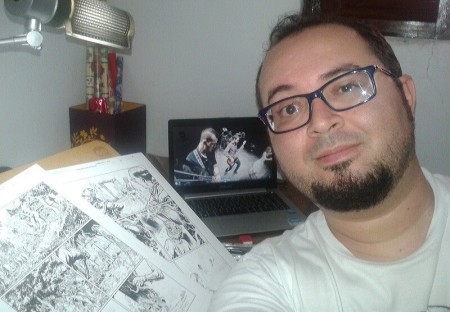Below is an interview with Crossed Plus One Hundred artist Gabriel Andrade. The interview was conducted in mid-2015 by Flavio Pessanha who administers the Alan Moore Brazil (Alan Moore Br) Facebook page. The interview is appearing in English for the first time ever here; the full original Portuguese text appears after the English translation below. The English translation was also done by Pessanha, then I edited it slightly for readability, and added links and images.

Gabriel Andrade Jr. image via Facebook.
Alan Moore Br: Gabriel, could you please tell us about the beginnings of your career as an illustrator, and how you decided to switch from economics to art?
Gabriel Andrade Jr.: The arts – more precisely illustration and music – have always been my passion and that’s where I spent most of my time. But in my adolescence I discovered philosophy and politics, and that also fascinated me. In the end, however, I couldn’t deny my artistic streak. (laughs) I chose to read Music at university, as I didn’t see myself as a graphic designer or didn’t see that there was a market for that.
When opportunities to show my portfolio drawings started to arise, I didn’t think twice and invested all I could in this process. As I didn’t know anything regarding this field, I had help from my friends Milena Azevedo (GHQ blog), Miguel Rude and Wendell Cavalcanti (both artists and comic writers). They were already in the business and they were my gurus when it all started for me.
You have worked for Dark Horse, Atlantic and you are now with Avatar. How did you get started working for Avatar?

Lady Death artwork by Gabriel Andrade
Towards the end of 2009 I had finished Die Hard at Boom!Studios and they [Avatar] needed an artist for Lady Death, so I created a fancy illustration for the poster and the final artwork. After that, I signed my first contract with them. (laughs)
How did Alan Moore find you? Were you surprised?
We both did work for Avatar’s special God is Dead [Book of Acts Alpha], but in separate short stories. William [Christensen], the editor-in-chief, showed my work to Alan and then we agreed that we were going to develop the new series.
In a recent interview with Pádraig O’Mealóid Alan Moore said that your art is spectacular and he called you ‘real old-school brilliant’, which is a humongous compliment. What are your main influences and how did you learn to draw?
My first influence didn’t come from comics, but from real life. As a child I drew everything I saw and, as my parents were teachers, at home we had a huge variety of illustrated science books, and many magazines and educational posters. (more…)










